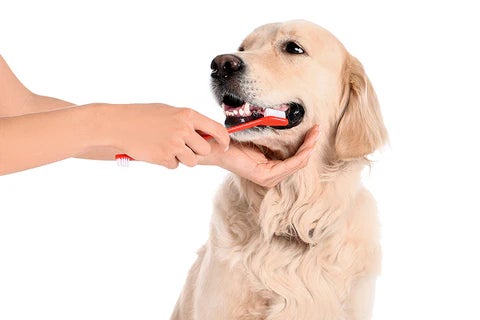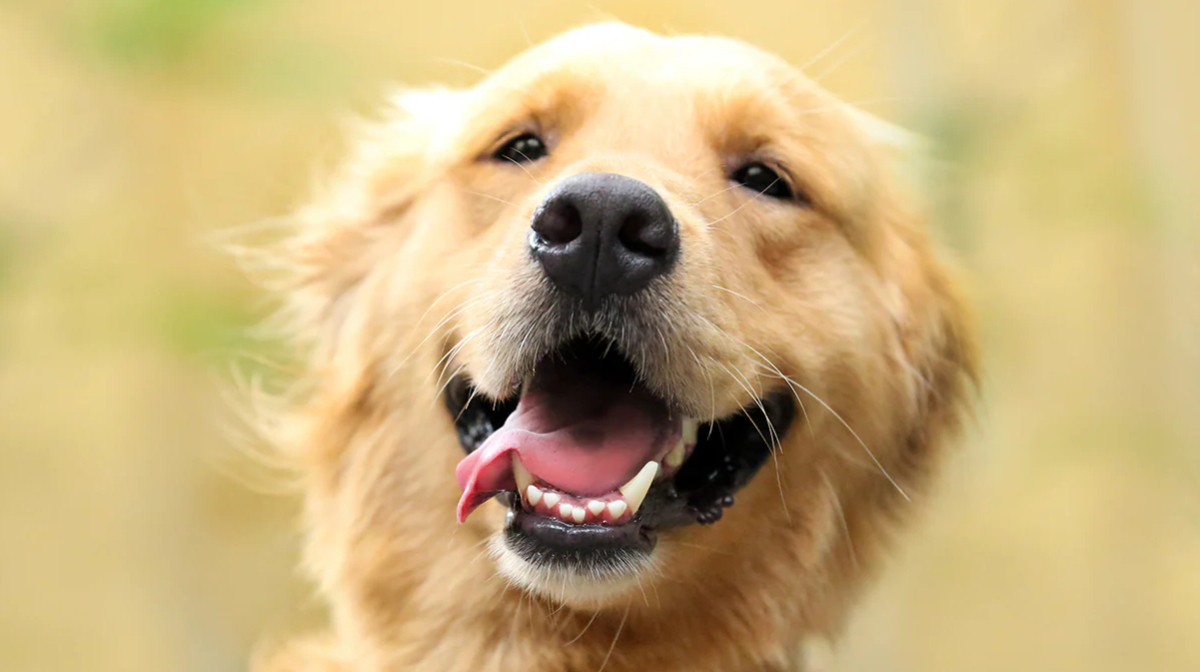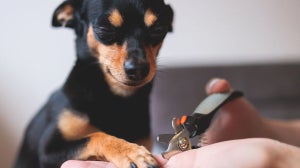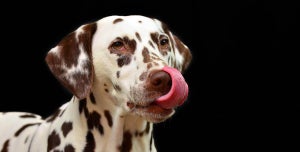
A dog's oral health is just as important as our own. Poor dental care can lead to a build-up of plaque and tartar, which, when left untreated, leads to periodontal disease.
The gums are a protective barrier preventing bacteria from your dog's mouth entering the body. Periodontal disease causes inflammation of the gums, allowing bacteria to enter the bloodstream and other organs.
That's why regular dental care should be part of every dog's routine.
The good news is that even if you can't brush daily, you can still keep your dog's teeth and gums clean and healthy.
So, in the next few minutes, we'll look at signs of dental issues in dogs, some tips for at-home oral care, how pet parents can get help to reduce plaque on the surface of their dog's teeth, and professional cleaning options.
The importance of dog dental care
Good oral hygiene is just as crucial for dogs as for humans. Poor dental care could easily lead to several serious medical issues for your dog.
Plaque and tartar on the teeth cause reddening and inflammation of the gums, called gingivitis, which, when left untreated, leads to gum disease. This is known as periodontal disease.
Your dogs' mouths (just like humans) naturally contain millions of bacteria. Plaque on the teeth causes gingivitis. If left untreated, the inflamed gums are damaged, and bacteria can penetrate the gums, entering the bloodstream and reaching the body's major organs.
Besides the medical implications, dental issues can also be extremely painful, yet dogs are stoic animals, and they hide their pain from you. So, you have to be able to spot these signs.
As a dog parent, you've got to understand that ensuring your dog receives regular dental care is an essential way to keep your dog healthy and happy for years to come.
How to clean your dog's teeth at home?
While this might look all too easy, cleaning your dog's teeth requires gentle skills and patience. This is how you should clean your dog's teeth.
- Brushing Your Dog's TeethThe gold standard for at-home dental cleaning is manually brushing your dog's teeth. Brushing removes the build-up of plaque that can damage gums and lead to tooth loss.

Follow these tips for an effective brushing routine:
You have to get your dog comfortable with having their mouth handled. You can give your dog dental treats like GREENIES™ Daily Dog Dental Treats<> to lick as you gently lift their lips and touch their teeth.
Introduce the taste of the dog toothpaste by applying some on your finger and allowing your dog to lick the paste. Repeat this process. You should get a toothpaste formulated just for dogs. Never use human dental care products.
Then, you want to get them familiar with the toothbrush. Start by wetting a soft-bristle brush and adding a pea-sized amount of veterinarian-approved dog toothpaste. Then, gently hold your dog's snout closed to prevent chewing as you insert the brush. Using your thumb on the same hand controlling the muzzle, lift your dog's upper lip and brush the prominent canine teeth in small circular motions, focusing especially along the gumline. James Wellbeloved™ Accesia Softly Swipes Dog Brushes could be handy here. It uses a unique wiping action to clean teeth and freshen breath.
Once your dog feels comfortable with brushing their prominent canine teeth, you can gradually progress to brushing farther back into the mouth to reach the molar teeth. Carefully slip the toothbrush just past the corner of your dog's lips and inside their cheeks to access these rear teeth. Start by gently brushing along the gumline of the upper back teeth using small circular motions. Then, allow your dog to open their mouth slightly so you can repeat this along the lower gum line.
Lift your dog's top lip to brush his front incisors gently while holding his mouth closed.
Dental Chews Dental chews are carefully designed to help remove plaque. They are more passive dental care options if your dog dislikes brushing.Your dog's enamel is much thinner than your enamel, and the strength of the dog's jaw is far greater than yours, so it's important to choose dental chews made with a safe texture. Some products are too hard and can damage your pet's enamel causing painful tooth fractures.
Dental Toys It's possible before now you've searched on Google "how to clean your dog's teeth without brushing," right? Interactive dental toys that dogs chew on may also provide some dental benefits. Choose textured rubber toys that gently clean teeth during play.Dental toys should always be used under supervision, not left unattended with dogs.
How do you remove plaque from a dog's teeth?
Plaque is most effectively removed from your dog's teeth by regular at-home brushing and professional veterinary dental cleanings.
Plaque that is not removed from your dog's teeth mineralizes into tartar over time, which can exacerbate gum disease. Keeping teeth free of plaque is imperative for good oral health.
The gold standard home care method is brushing using veterinary-approved dog toothpaste and a medium-bristled toothbrush. Brush teeth in small circles with gentle pressure, focusing on the gum line and inner or outer surfaces to remove the plaque.
Your vet should check any remaining build-up annually. They may recommend a routine scale and polish under anaesthetic to remove any existing tartar.
Plaque and tartar build up can damage the dog's gums and supporting structures around the teeth causing pain, loose teeth, and infections. Prevention by establishing a daily oral care routine at home for your dog is so important to protect both his oral and general health and wellbeing.
Professional dog teeth cleaning vs at-home methods
Professional dentals thoroughly remove plaque and tartar, leaving the surface of the teeth clean.
A dental procedure carried out under anaesthesia by a veterinarian reduces infection risks associated with untreated periodontal disease.
Regular at-home brushing and dental treats or chews provide effective preventative care between professional dental treatments. Although plaque removal may not be as complete, consistency greatly benefits your dog's oral health.
Budget-friendly brushes, toothpaste, and scientifically proven textured chews can all help prevent plaque build-up. They also encourage positive associations with handling your dog's mouth at home.
But you must be aware that dental disease can progress if areas aren't treated effectively. It usually occurs below the gumline, where it goes unnoticed.
So, there are times when professional veterinary care becomes necessary.
One such scenario would be annually for dogs with apparent gum recession, loose teeth, persistent bad breath, or significant tartar deposits that daily efforts haven't sufficiently improved.
Signs of dental issues in dogs
- Bad BreathChronic bad breath, especially when accompanied by red swollen gums, signals plaque and tartar build-up. As bacteria multiply in plaque, they release smelly gases that produce halitosis. Persistent bad breath often results from inflamed gums and plaque progression that need veterinary attention.
- Discoloured TeethOver time, accumulated tartar causes yellow or brown discolouration on your dog's once-pearly whites. Your veterinarian should check this as it can make oral health issues progress faster.
- Excessive DroolingSome breeds of dogs naturally produce lots of saliva, so knowing what's normal for your dog is important. However, increased drooling when not expecting food may occur with gum pain, fractured teeth, damage to the tissues of your dog's mouth or growths, or other mouth irritation. Dental issues can make everyday life, like playing or eating, painful. It's important to spot the signs if your dog starts behaving differently when using its mouth.
- Swelling Along JawlineVisible swelling below the eyes or along the jawline can signal an oral infection, such as an abscessed tooth or advanced periodontal disease. This can be painful for your dog and requires urgent veterinary attention.
- Loose or Missing TeethWobbly teeth that eventually fall out result from severe gum disease, eroding the periodontal ligaments anchoring teeth to the bone. The infection also destroys jawbone support over time. This is a very painful condition for your dog. Although dogs hide pain well, any loose teeth require immediate veterinary attention as extractions may be necessary.
- Difficulty EatingAn underlying dental issue is likely if your dog abruptly loses interest in eating hard kibble or seems painful chewing treats they once loved. Fractured or broken teeth, oral masses, injury to the mouth or jaw, and gum disease all negatively impact the ability to comfortably use the mouth for eating.
Is it too late to brush dogs teeth?
It's never too late to start caring for your dog's oral health. But ideally, tooth brushing and other dental care should begin early as part of a comprehensive puppy checklist once the adult teeth are all present.
Even if prior dental hygiene was neglected, introducing brushing and professional veterinary care provides benefits at any age. As the saying goes, it is better late than never.
The key is consistency moving forward. Work positive daily tooth brushing into your existing routine. You can always ask your veterinarian about dental treatments to make at-home maintenance easier if your dog doesn't tolerate having their teeth brushed.
As long as plaque and tartar build-up is continually controlled and no advanced periodontal infection exists, excellent oral health is still achievable.
Some simple tips for gaining traction if you're late to implement teeth brushing include making it a two-person game, using finger brushes initially, and rewarding your dog with small treats.
Even if daily brushing proves overwhelmingly difficult, you can try consulting your veterinarian every 6-12 months. This can help you spot periodontal disease early.
Conclusion
When all's said and done, keeping up with your dog's dental hygiene through brushing, toys, and annual veterinary cleaning is good for your dog's health and happiness.
The build-up of plaque and tartar on your pet's teeth causes gum disease, which can seriously harm his quality of life. We get that brushing canine teeth is easier said than done, but giving it a solid effort makes a big difference.
And if you've thought about how to clean your dog's teeth without brushing, scientifically proven dental treats or water additives are always helpful. Work with your veterinarian to find your canine friend's perfect dental care plan.
Your dog brings you so much joy. Don't they deserve healthy teeth and gums?
You should also read our article on dog grooming if you want more insight on how to care for your dog.
Show your dog some love by protecting their dental health. It's one of the best gifts any dog parent can give.
Frequently Asked Questions
Is it worth getting your dog's teeth cleaned?
Yes, professional dog dental cleaning by your veterinarian is worth the investment for your furry friend's ongoing oral health and overall wellbeing. Never let a groomer clean your dog's teeth - it is only a job for the vet professionals! It's much like we go to a dentist, not a hairdresser for our teeth!
What's the best way to clean a dog's teeth?
Daily brushing using dog toothpaste and a medium -bristled toothbrush designed just for canine mouths is the gold standard for cleaning dogs' teeth and preventing plaque build-up at home between professional dental cleaning by a vet.

Related Articles








